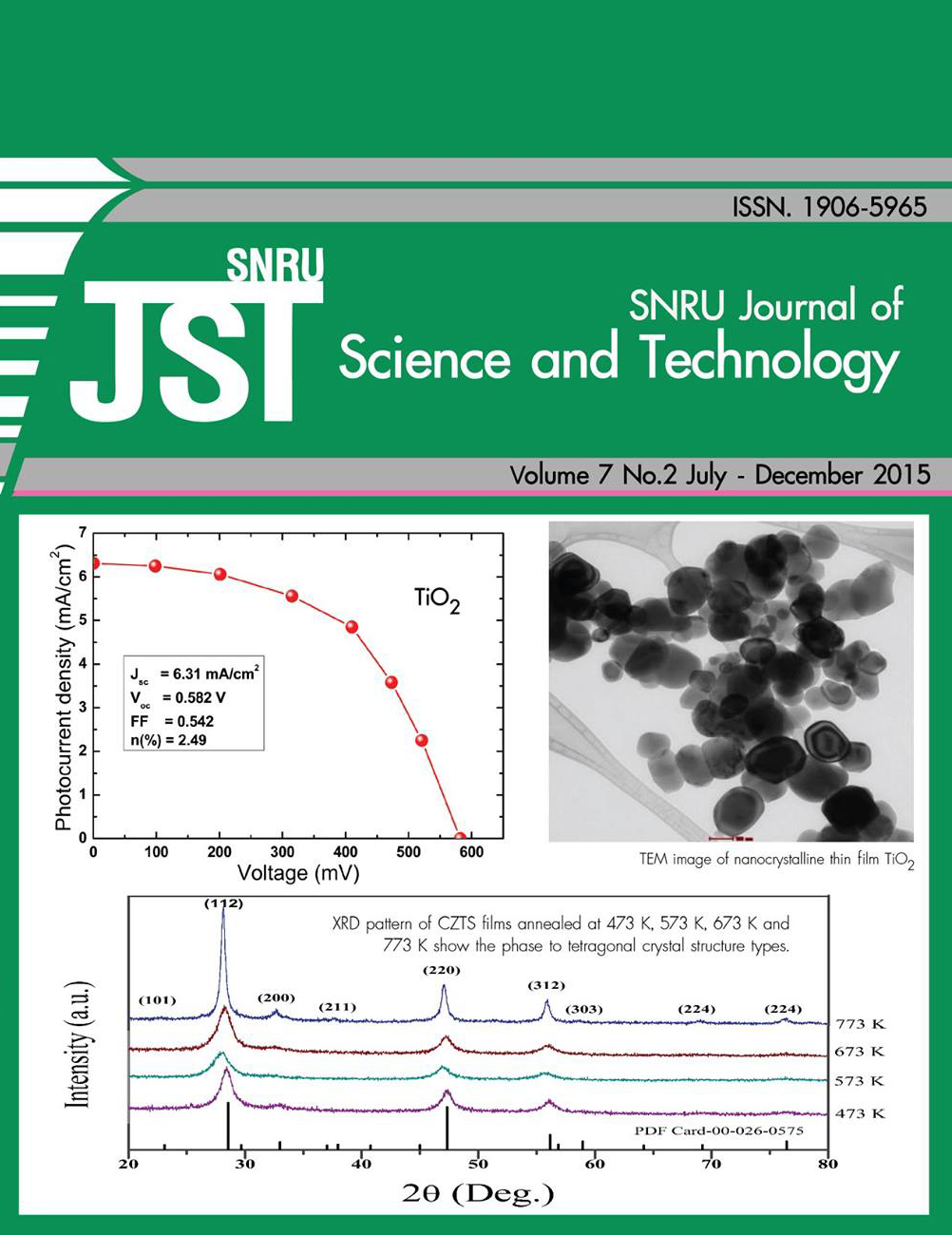รูปแบบการพัฒนาความสำเร็จของโครงการพัฒนาศักยภาพหมู่บ้าน/ชุมชน (SML) ของกลุ่มจังหวัดร้อยแก่นสารสินธุ์ A model for developing the success of the community’s capacity development for the Provincial Roi Kaen Sarn Sin cluster
Keywords:
การพัฒนาศักยภาพหมู่บ้าน/ชุมชน, ร้อยแก่นสารสินธุ์, รูปแบบการพัฒนาความสำเร็จAbstract
งานวิจัยนี้นำเสนอรูปแบบการพัฒนาความสำเร็จของโครงการมีพัฒนาศักยภาพหมู่บ้าน/ชุมชน (SML) ของกลุ่มจังหวัดร้อยแก่นสารสินธุ์ มีวัตถุประสงค์เพื่อ 1) ศึกษาปัจจัยที่ส่งผลต่อการพัฒนาความสำเร็จของโครงการ 2) ศึกษากระบวนการการพัฒนาความสำเร็จของโครงการ และ 3) การสร้างรูปแบบการพัฒนาความสำเร็จของโครงการพัฒนาศักยภาพของหมู่บ้าน/ชุมชน กลุ่มตัวอย่างได้แก่ โครงการพัฒนาศักยภาพหมู่บ้าน/ชุมชน ในกลุ่มจังหวัดร้อยแก่นสารสินธุ์ จำนวน 382 โครงการเครื่องมือที่ใช้ในการวิจัยได้แก่ แบบสอบถามที่มีค่าความเที่ยงตรงจากการประเมินของผู้เชี่ยวชาญ จำนวน 3 ท่านโดยได้ค่า IOC รายข้อ ตั้งแต่ 0.67-1.00 และ การทดลองกับกลุ่มที่ไม่ใช่กลุ่มตัวอย่าง 30 โครงการ/คน เพื่อหาค่าความเชื่อมั่นของแบบสอบถามทั้งฉบับโดยวิธีการหาค่าสัมประสิทธิ์อัลฟา ตามวิธีการของ ครอนบาค (Cronbach) ได้ค่าความเชื่อมั่นของแบบสอบถามทั้งฉบับเท่ากับ 0.9 วิธีดำเนินการวิจัยแบ่งออกเป็น 2 ระยะ ระยะที่ 1 การศึกษาปัจจัยเชิงสาเหตุที่ส่งผลต่อรูปแบบการพัฒนาความสำเร็จของโครงการ และระยะที่ 2 สร้างรูปแบบการพัฒนาความสำเร็จของโครงการ สถิติที่ใช้ในการวิจัย การวิเคราะห์เชิงพรรณนา เพื่ออธิบายข้อมูลทั่วไป สถิติที่ใช้ได้แก่ ความถี่ ร้อยละ และการพรรณนาความสถิติวิเคราะห์เพื่อทดสอบสมมิฐานในการวิจัย ใช้การวิเคราะห์สมการเชิงโครงสร้างโดยใช้โปรแกรมลิสเรล (LISREL) และสหสัมพันธ์เพียรสัน (Pearson Correlation) ผลการวิจัยพบว่า 1. ปัจจัยที่มีผลต่อการพัฒนาความสำเร็จของโครงการพัฒนาศักยภาพของหมู่บ้าน/ชุมชน ของกลุ่มจังหวัดร้อยแก่นสารสินธุ์ พบว่า โมเดลความสัมพันธ์เชิงสาเหตุของการพัฒนาความสำเร็จของโครงการพัฒนาศักยภาพของหมู่บ้าน มีความสอดคล้องกับข้อมูลเชิงประจักษ์ ตัวแปรทั้งหมดในโมเดลสามารถอธิบายความแปรปรวนของการพัฒนาความสำเร็จของโครงการได้ร้อยละ 90 ตัวแปรที่มีอิทธิพลทางตรงต่อการพัฒนาความสำเร็จของโครงการอย่างมีนัยสำคัญทางสถิติได้แก่ ปัจจัยด้านผู้นำ ปัจจัยด้านการมีส่วนร่วมของประชาชน ปัจจัยด้านคณะกรรมการ ปัจจัยด้านการบริหารจัดการการเงิน ปัจจัยด้านการประชาสัมพันธ์ ปัจจัยด้านการควบคุม และปัจจัยด้านการจัดซื้อจัดจ้าง สำหรับตัวแปรคั่นกลางที่มีผลต่อความสำเร็จพบว่า ปัจจัยด้านการบริหารจัดการและปัจจัยด้านวัฒนธรรมองค์กรมีอิทธิพลทางตรงกับระดับความสำเร็จของโครงการตามลำดับ 2. ผลการศึกษากระบวนการการพัฒนาความสำเร็จของโครงการพัฒนาศักยภาพของหมู่บ้าน/ชุมชน ของกลุ่มจังหวัดร้อยแก่นสารสินธุ์ พบว่าเกิดจากปัจจัยที่มีผลต่อความสำเร็จประกอบด้วย ปัจจัยด้านผู้นำ ปัจจัยด้านการมีส่วนร่วมของประชาชน ปัจจัยด้าน
คณะกรรมการ ปัจจัยด้านการบริหารจัดการการเงิน ปัจจัยด้านการประชาสัมพันธ์ ปัจจัยด้านการควบคุม และปัจจัยด้านการจัดซื้อจัดจ้าง ปัจจัยด้านการบริหารจัดการและปัจจัยด้านวัฒนธรรมองค์กร 3. การสร้างรูปแบบการพัฒนาความสำเร็จของโครงการพัฒนาศักยภาพของหมู่บ้าน/ชุมชน ของกลุ่มจังหวัดร้อยแก่นสารสินธุ์ สามารถอธิบายความสัมพันธ์ของการพัฒนาความสำเร็จของโครงการพัฒนาศักยภาพหมู่บ้าน/ชุมชน โดยเริ่มต้นจากการประชุมประชาคมของประชาชนในหมู่บ้าน/ชุมชนร่วมกันแสดงความคิดเห็นชี้แจงเหตุและความสำคัญของปัญหาและที่มาของโครงการ SML ซึ่งต้องมีกลุ่มบุคลากรหรือคณะกรรมการเพื่อรับผิดชอบโครงการ ดังนั้นจึงต้องมีการเลือกคณะกรรมการโครงการเพื่อประสานงานโดยการลงประชามติของประชาชนในชุมชนเลือกสรรซึ่งไม่ได้มาจากผู้ใหญ่บ้านหรือผู้นำเป็นคนแต่งตั้ง เมื่อมีการคัดเลือกคณะกรรมการประจำโครงการได้แล้วนั้นจะต้องมีการจัดอบรมให้ความรู้แก่คณะกรรมการ SML ร่วมกับประชาชนในชุมชนเพื่อให้เกิดการดำเนินการเสนอโครงการ SML ที่จะเป็นประโยชน์สำหรับชุมชนทั้งนี้จะต้องมีการนำเสนอโครงการกับหน่วยงานภาครัฐที่รับผิดชอบและมีการสรุปผลการดำเนินงานตามโครงการ
This research presents a model for developing the success of the community’s capacity development for the Provincial Roi Kaen Sarn Sin Cluster. The purposes of this research were to 1) examine the factors affecting the success of the community’s capacity development (SML) for the Provincial Roi Kaen Sarn Sin Cluster, 2) investigate the process of the community’s capacity development, and 3) to create a model of the community’s capacity development. The samples of SML were 382 projects. The instruments used in the research involved a questionnaire. The Index of congruence (IOC) was reviewed by three experts with validity between 0.67-1.00. The tryout of a non-sample group involved 30 projects / persons. The overall reliability for the set of questionnaires utilised Cronbach’s alpha coefficient, which was of 0.92. The research was divided into two phases: Phase I was related to examining causal factors affecting the community’s capacity development, and Phase II was related to a model development. A descriptive approach was used to provide basic information. The statistics used were frequency, percentage, and descriptive statistical analysis to test the research hypothesis. Structural Equation Analysis utilized LISREL and Pearson Correlation. The results revealed that 1) the factors affecting the success of the community’s capacity development were discovered. The Causal Relationship Model of the successful development for SML had a consistency with the empirical data. All variables in the model were able to explain the variation for the project development, with 90 percent of the variables influencing the success of the projects being statistically significance, including the following factors: leadership, public participation, committee, financial management, public relations, controlling, and procurement. In addition, the intermediate variables affecting success were risk management and organizational culture, which had a direct influence towards the success of the project. 2. The results after the process investigation for the success of SML revealed that the factors affecting success also involved leadership, public participation, committee, financial management, public relations, controlling, procurement, risk management, and organizational culture. 3. The establishment of the community’s capacity development for the Provincial Roi Kaen Sarn Sin Cluster was able to explain the relationship of the development of the project success. The following activities were implemented: public meeting in the villages/communities to discuss the rational and importance of problems, and background of the SML project. The selected person in charge, or the committee, taking whole responsibility for project operation were obtained through the public vote from communities, rather than being appointed from the head of the village or the community leader. The knowledge training for SML committee and people in the communities was then held in order to encourage the proposals for SML projects that could be of benefit for communities. In addition, the project was required to propose development agendas to relevant government organizations. The summary of the operational project was also noted.









